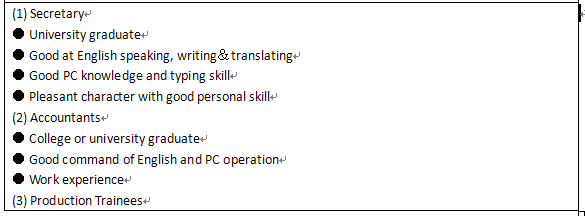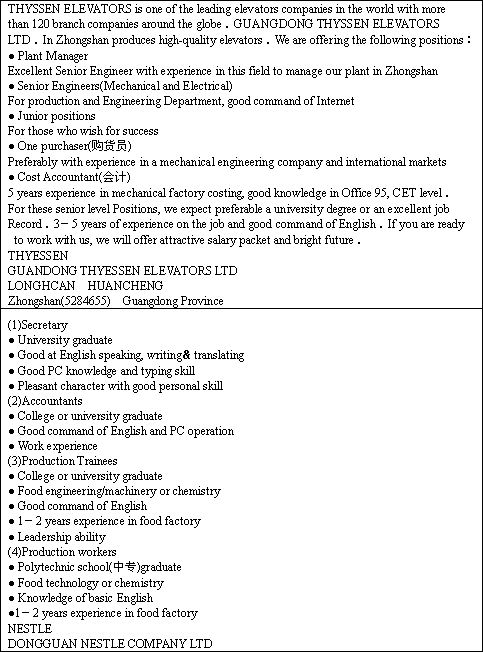网址:http://m.1010jiajiao.com/timu3_id_3154430[举报]
| |||||||||||||||||||||||||||||||||||||||||||||
| |||||||||||||||||||||||||||||||||||||||||||||



B. a production worker in NESTLE
C. a senior engineer in THYSSEN
D. a cost accountant in THYSSEN
B. NESTLE is a company only producing chemical products
C. NESTLE asks for good command of English in every Position
D. THYSSEN needs a senior sales manager to sell its products in Asia
B. a purchaser in THYSSEN
C. a secretary in NESTLE
D. an accountant in NESTLE
What is the difference between a college and a university? This is a good question for students who want to attend a college or a university in the United States.
Colleges and universities have many things in common. Both provide a greater understanding of the world and its past. Both provide education in the arts and sciences. And both can help prepare young people to earn a living.
Students who complete their undergraduate studies either at a four-year college or a university receive a bachelor’s degree. One difference is that many colleges do not offer graduate studies.
Universities are generally bigger, offer more programs and do more research. Modern universities developed from those of the Middle Ages in Europe. The word “university” comes from the Latin “universitas”. This described a group of people organized for a common purpose. The word “college” comes from a Latin word with a similar meaning, “collegium”. In England, colleges were formed to provide students with places to live in. Usually each group of students was studying the same thing. So college came to mean an area of study. But a college can also be a part of a university. The first American universities divided their studies into a number of areas and called each one a college. This is still true.
Programs in higher learning may also be called schools. The University of Arizona in Tucson, for example, has 18 colleges and 10 schools. They include the colleges of pharmacy (制药学), education, engineering and law. They also include the schools of architecture, dance and public administration.
College is also used as a general term for higher education. A news report might talk about “college students” even if they include students at universities. Or someone might ask, “Where do you go to college?”
Today, most American colleges offer an area of study called liberal arts. These are subjects first developed and taught in ancient Greece. They include language, philosophy and mathematics. The purpose is to train a person’s mind instead of teaching job skills.
1.The passage is probably written to _________.
A.persuade students to go to college instead of schools
B.tell students the differences between colleges and universities
C.help students make a better choice of what kind of colleges they should go to
D.inform students about how much they are going to spend in going to college
2.When the term “college students” appears in a newspaper, it may refer to ________.
A.only students studying in colleges
B.students studying in colleges in the USA
C.only students studying in universities
D.students receiving higher education
3.What can we learn from the passage?
A.Both universities and colleges include different schools.
B.The purpose of liberal arts is to train a person’s job skill.
C.Both universities and colleges can help prepare students to make a living.
D.Most American universities have 18 colleges and 10 schools.
4.The area of study called liberal arts is designed to _______.
A.get students ready to earn a living
B.teach students subjects from engineering to philosophy
C.help students achieve a stronger and clearer mind
D.encourage more students to begin the study of arts
查看习题详情和答案>>
What is the difference between a college and a university? This is a good question for students who want to attend a college or a university in the United States.
Colleges and universities have many things in common. Both provide a greater understanding of the world and its past. Both provide education in the arts and sciences. And both can help prepare young people to earn a living.
Students who complete their undergraduate studies either at a four-year college or a university receive a bachelor’s degree. One difference is that many colleges do not offer graduate studies.
Universities are generally bigger, offer more programs and do more research. Modern universities developed from those of the Middle Ages in Europe. The word “university” comes from the Latin “universitas”. This described a group of people organized for a common purpose. The word “college” comes from a Latin word with a similar meaning, “collegium”. In England, colleges were formed to provide students with places to live in. Usually each group of students was studying the same thing. So college came to mean an area of study. But a college can also be a part of a university. The first American universities divided their studies into a number of areas and called each one a college. This is still true.
Programs in higher learning may also be called schools. The University of Arizona in Tucson, for example, has 18 colleges and 10 schools. They include the colleges of pharmacy (制药学), education, engineering and law. They also include the schools of architecture, dance and public administration.
College is also used as a general term for higher education. A news report might talk about “college students” even if they include students at universities. Or someone might ask, “Where do you go to college?”
Today, most American colleges offer an area of study called liberal arts. These are subjects first developed and taught in ancient Greece. They include language, philosophy and mathematics. The purpose is to train a person’s mind instead of teaching job skills
- 1.
The passage is probably written to _________
- A.persuade students to go to college instead of schools
- B.tell students the differences between colleges and universities
- C.help students make a better choice of what kind of colleges they should go to
- D.inform students about how much they are going to spend in going to college
- A.
- 2.
When the term “college students” appears in a newspaper, it may refer to ________
- A.only students studying in colleges
- B.students studying in colleges in the USA
- C.only students studying in universities
- D.students receiving higher education
- A.
- 3.
What can we learn from the passage?
- A.Both universities and colleges include different schools
- B.The purpose of liberal arts is to train a person’s job skill
- C.Both universities and colleges can help prepare students to make a living
- D.Most American universities have 18 colleges and 10 schools
- A.
- 4.
The area of study called liberal arts is designed to _______
- A.get students ready to earn a living
- B.teach students subjects from engineering to philosophy
- C.help students achieve a stronger and clearer mind
- D.encourage more students to begin the study of arts
- A.

